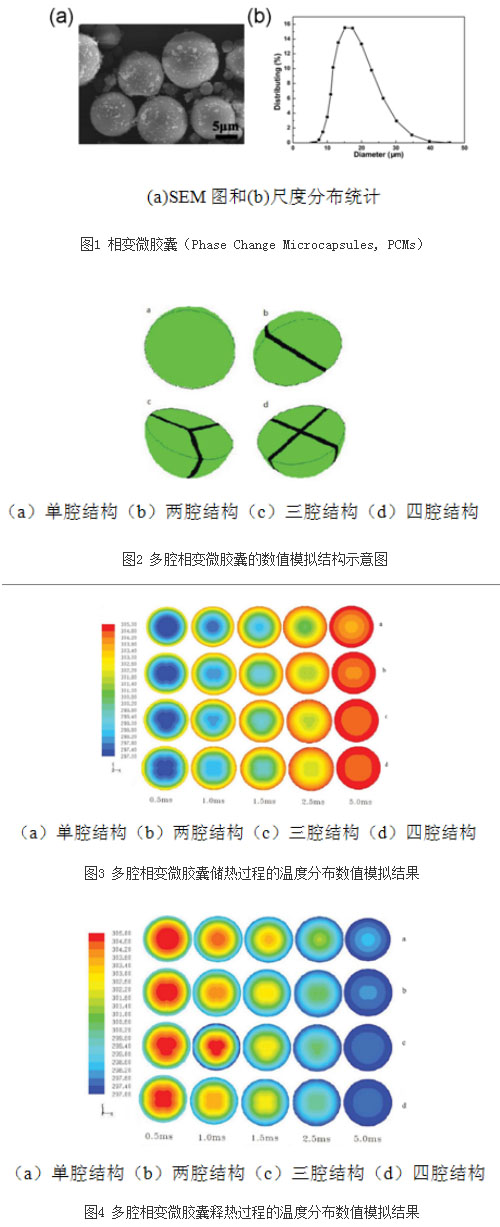
Phase change energy storage materials and related technologies are considered to be emerging interdisciplinary fields involving materials and energy sciences. Their development aims to solve the problem of energy mismatch in time and space scales and improve energy efficiency. Recently, researchers at the Research Center for Heat and Mass Transfer at the Institute of Engineering Thermophysics, Chinese Academy of Sciences have successfully developed a novel micro-scale energy storage unit, Phase Change Microcapsules (PCMs). This new type of material uses a controlled diaphragm growth technique to separate the micro-scale spherical shell into several independent chambers (Figure 1), and each chamber can be filled with different types and contents of phase change materials. This micro-scale control method greatly expands the phase transition temperature range and can effectively solve problems such as liquid-phase flow and leakage during solid-liquid conversion. The thermal properties of PCMs directly determine the heat transfer performance of the PCMs. However, the heat transfer parameter data of these new materials are not yet complete, and the corresponding heat transfer and storage mechanisms have not yet formed. Therefore, it is imperative to develop thermal characterization methods and heat transport mechanisms for these new materials.
At present, researchers have conducted more in-depth research on this new material category. Researchers developed experimental characterization techniques and numerical simulation methods for PCMs. The effective thermal conductivity, endothermic coefficient, and specific heat of different density PCMs were measured by frequency domain 3ω technique and calorimetry technique. At the same time, the sensible heat capacity method (Fig. 2) was used to simulate the heat storage and heat release process of PCMs. Experimental measurements show that the effective thermal conductivity and endothermic coefficient of PCMs peak at the phase transition temperature of the phase change nuclear material. In addition, the effective thermal conductivity and endothermic coefficient of PCMs increase significantly with the increase of density due to the coupling effect of heat transfer in solid phase and gas phase. The numerical simulation results show that two control methods, such as increasing the number of chambers and increasing the thermal conductivity of the cavity wall materials, can effectively accelerate the heat transfer and storage processes of the PCMs, and at the same time improve the temperature uniformity of the storage and heat release processes. The research results of this type of work laid the foundation for the structural optimization design of PCMs.
The above work was supported by the National Natural Science Foundation of China (51336009) and the "973 Program" sub-project (2012CB933200). The research results have been published in English monographs and published in Phase Transitions: A Multinational Journal, 2015, 88(7):704-715.
PVD (physical vapor deposition) coating is a type of Surface Treatment that is used to improve the performance of metal parts, by applying a thin layer of material onto the substrate through a vacuum chamber. This process provides a range of benefits, including increased hardness, improved wear resistance, and enhanced corrosion resistance.
PVD coatings are typically applied to metals such as stainless steel, titanium, and aluminum. They are particularly useful in applications where the substrate is subjected to high wear and tear, as the coatings help to reduce friction and limit the damage caused by abrasion. They are also used in the automotive industry to provide an aesthetic and functional finish to exterior parts.
PVD coatings can be tailored to meet specific application requirements, with a range of coating materials available, including titanium, chromium, and zirconium. These coatings can be deposited in a range of colors, such as black, gold, and silver, giving designers and manufacturers the flexibility to create parts with the desired appearance.
Another key benefit of PVD coating is its durability. The thin layer of coating can offer a long-lasting, high-performance finish, even in harsh or corrosive environments. This makes them particularly useful in outdoor applications, and in settings such as aerospace and medical devices, where reliability and durability are critical.
PVD coating is applied through a series of steps, including cleaning and pre-treatment of the substrate, coating material deposition, and post-treatment, such as polishing or annealing. The result is a thin, uniform layer of coating that provides a range of functional and aesthetic benefits.
In conclusion, PVD coating is a versatile and effective surface treatment for metal parts. It offers a range of benefits, including improved hardness, wear resistance, and corrosion resistance, as well as aesthetic options. By enhancing the performance and durability of metal parts, PVD coating plays an important role in improving the reliability and efficiency of a range of industries and applications.
Pvd Process,Pvd Coating Process,Pvd Metal,Pvd Vacuum Plated
Lizhi Precision Manufacturing Technology Co.,Ltd , https://www.lzautoindust.com
